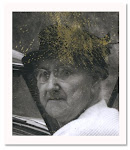Another slide purchased at the estate sale several weeks ago.

Click on image to see it larger.
This was taken in 1955 on Fremont Street.
Fremont Street dates back to 1905, when Las Vegas itself was founded. Fremont Street was the first paved street in Las Vegas in 1925 and received the city's first traffic light in 1931. Fremont Street also carried the shields of U.S. 95, U.S. 93, and U.S. 466 before the construction of the interstates.
While gambling was well established prior to being legalized, the Northern Club in 1931 received one of the first 6 gambling licenses issued in Nevada and the first one for Fremont Street. (SOURCE: Wikipedia)In the distance you can see one of the first big time casinos along the Strip called the Golden Nugget which still exists.

Click on image to see it larger.
A bit of history about the Golden Nugget.
Desperate to lure people to the state, Nevada legislators legalized gambling in 1931. Even so, Las Vegas remained a dusty saloon town full of small-time gambling operations. Guy McAfee embodied the casino owner of his day.
The Captain
McAfee, known around town as "the Captain," served for years as commander of the Los Angeles Police Department vice squad. While heading the vice squad, McAfee simultaneously pursued a profitable life in the underground. He owned saloons and brothels and had ties to organized crime.
In the 1920s and early 30s, while his wife worked as a high-profile Hollywood madam, McAfee operated a busy and lucrative circuit of gambling houses. His connections with mobsters and position with the L.A.P.D. proved invaluable, making him privy to inside information and especially lucky in his ability to stay one step ahead of raids.
Bowron Cleans Up L.A.
But in the late 1930s, Judge Fletcher Bowron was elected as the new mayor of Los Angeles. Bowron had campaigned heavily on a platform pledging to clean up Los Angeles' sordid underworld that had been allowed to flourish for the last two decades. Upon his election, Bowron lived up to his promises and began upending longstanding narcotic, prostitution and gambling operations like McAfee's.
As soon as the extent of the police commander's outfit was discovered, McAfee was forced to resign his post and, facing possible legal action, flee the city. Lured both by Las Vegas' proximity to Los Angeles and its permissiveness, McAfee arrived in Las Vegas in 1938.
McAfee Arrives on Highway 91
Eager to pick up his business career where he had left off, the next year, McAfee bought the Pair-O-Dice Club on Highway 91 from owners Frank and Angelina Detra (John Detra, son of the owners, remembers Al Capone visiting his parents, possibly planning to establish operations in Vegas before he was jailed). McAfee renamed the club the "91 Club" (later, it would become part of the Last Frontier), and ever the opportunist, delayed the club's grand opening to coincide with Clark Gable and Ria Langham Clark's infamous divorce in March 1939. McAfee's tie-in with the immense publicity garnered by the Gables' divorce was a public relations coup.
McAfee would continue to build up his interests, arguably the most famous of which was his casino, the Golden Nugget. Upon its completion in 1946, the Golden Nugget was touted as the world's largest casino. Eventually, the Golden Nugget would fall under the ownership of another Las Vegas casino owner, Steve Wynn. (SOURCE: PBS/American Experience)
The question is, how many of these other businesses still exist along the strip?

















Are we riding with Eddie and Fred again?
ReplyDeleteThe cars of the 1950s are as imposing as linebackers. Great color for old slides too.
Oh I like the idea of those cars being linebackers. A very apt description.
Delete